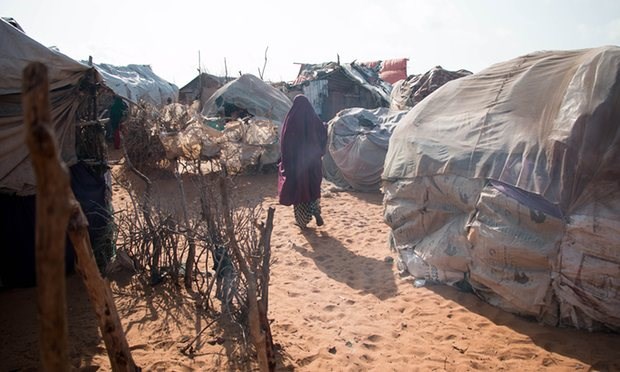
Thursday October 20, 2016

Since Kenya announced it was closing Dadaab, up to 400 people per day have been repatriated to Somalia. Photograph: Refugees Deeply
Authorities in Somalia have denounced the way refugees are being repatriated from neighbouring Kenya, after the Kenyan government announced it would close Dadaab, the world’s largest refugee camp, by the end of 2016.
Over the past five months, makeshift camps in Somalia’s southernmost border state have been swelling with families as thousands of refugees are repatriated as part of a UN scheme.
But Jubaland state authorities have now suspended the returns process, saying local services are overwhelmed and the repatriation process amounts to the “dumping of human beings in an undignified way”.
With Kenyan elections approaching and anti-refugee rhetoric spurred on by the fear of the Somali Islamist group al-Shabaab, the government announced in May that it would permanently close Dadaab – home to more than 320,000 Somalis spanning several generations – and send all Somali refugees home by the end of the year.
In May the Kenyan interior minister, Joseph Nkaissery, claimed al-Shabaab fighters were using the camp as a base for smuggling weapons. “For reasons of pressing national security that speak to the safety of Kenyans in a context of terrorist and criminal activities, the government of the Republic of Kenya has commenced the exercise of closing Dadaab refugee complex,” he said.
The United Nations and other aid groups have criticised the move, suggesting it may not be possible to force large numbers of people over the border into a country where a war is still raging.
The programme to repatriate the refugees was first launched after an agreement was signed between the Kenyan government, United Nations refugee agency (UNHCR) and the Somali federal government in December 2013.
Between December 2014 and the end of September 2016, 30,731 Somali refugees from Dadaab were repatriated. Most of them – 24,630 refugees – returned to Somalia in 2016, amid mounting pressure from the Kenyan government to clear Dadaab.
However, over the past few months, since the announcement to expedite the closure of Dadaab, the UNHCR and its partners say they have been transporting up to 400 people a day across the border into Somalia.
Officials in the port city of Kismayo said the returnees are essentially “squatting” on land that has not been officially set aside for them.
Many returners have reported poor conditions. Outside Kismayo, some 16,000 newly arrived refugees are camped in overcrowded and unsanitary conditions in shelters that they built themselves, with little access to medical care and no schools. Camps have few decent running water sources or latrines, leaving thousands of people at risk of disease.
Some families who arrived in Kismayo this year said they chose repatriation because they could no longer feed their families in Dadaab. Others said they feared being forced to leave Kenya without any UN support at all if they didn’t leave now.
The majority of people being returned are women, children, elderly or disabled – “the most vulnerable sectors of society,” according to the American Refugee Committee, an aid group providing healthcare and child protection in the camps.
Hubi Abdullahi Aden, a 44-year-old mother who managed to raise and educate seven children in Dadaab, said: “In Somalia, there’s no water, no schools … despite the promises they made, the UN backtracked from them. The house you see there I built myself.”
Aden, like many others who have returned to Kismayo, fears an impending onset of violence. Kismayo was only liberated from al-Shabaab in 2012. A fragile peace is maintained by local security forces, but outside the city much of Jubaland state remains an inaccessible battleground, with the danger of violence spilling over to other parts of the country.
The Kismayo area is already sheltering some 40,000 people displaced internally by conflict between al-Shabaab militants and the western-backed African Union and Somali national forces, and the services available are barely adequate to support a vulnerable local population.
Contrary to the terms they accepted when signing the repatriation agreement, instability means the federal government of Somalia cannot always access semi-autonomous Jubaland to support and resettle the returners, according to Jubaland state’s justice minister, Adam Ibrahim Aw Hirsi.
“On one hand we are [...] fighting al- Shabaab, and [on] another we are dealing with returning refugees and the IDPs [internally displaced people] that were already here, and our own communities. We don’t have the financial and human capacity to deal with all of this,” he added.
Meanwhile, a central condition of the repatriation package is that people give up their refugee status in Kenya. If violence worsens in Somalia, they will be unable to return to Dadaab, adding to the more than